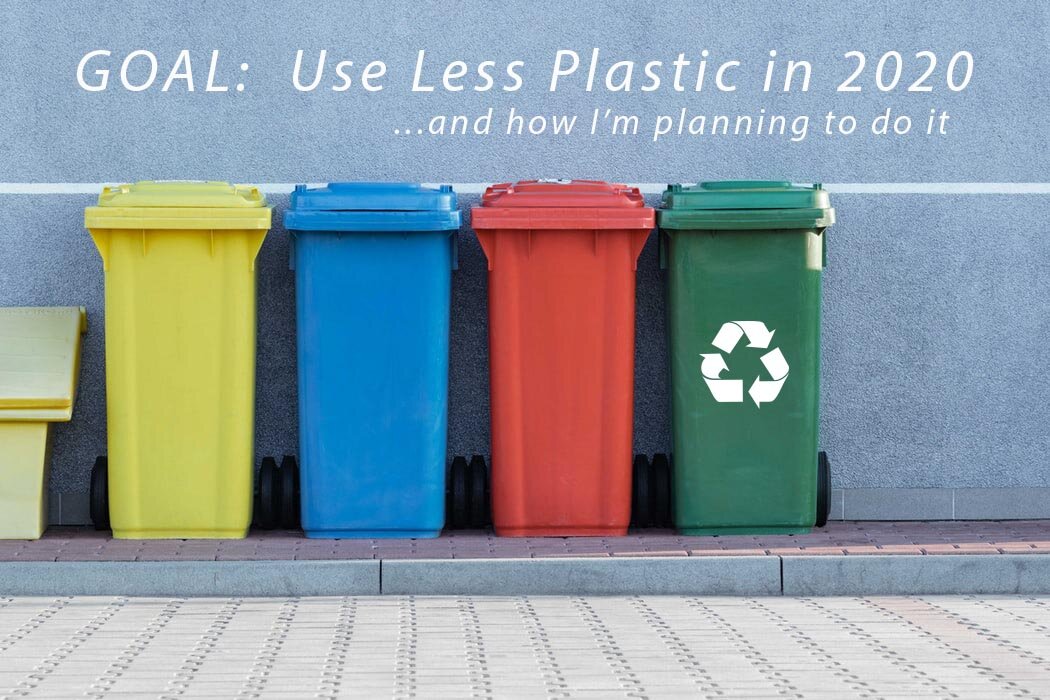Goal: Use Less Plastic in 2020
As I had mentioned previously in my “Goals for the New Year” post, one of my goals is to use less plastic in our daily lives. We already make an effort to recycle as much as possible and not be wasteful but watching the documentary “Broken: Recycling Sham” on Netflix was eye-opening. So much of what people put in the recycling bin ends up in landfills or the ocean in the end, as a lot of plastic is too difficult or expensive to recycle and it’s sorted out and discarded. (PS - if you haven’t watched this documentary yet, I highly recommend it!) If everyone were to decrease their use of plastic in small ways it would eventually decrease the demand and less plastic would be made and end up in the environment. Here I’m sharing some small ways we’re working towards less plastic in our lives. | This post contains affiliate links |
As Emily Ley would say, I’m striving for “progress, not perfection.” I am not planning on eliminating all plastic from our home overnight - after all that wouldn’t be environmentally responsible either. We have plenty of BPA-free Tupperware, kids plates, reusable bottles, containers, etc and they are serving us well - there’s no need to go chuck them in the trash now. It’s also impractical (and arguably impossible) for our family to totally eliminate plastic from our lives. - But moving forward, we will try to consume less plastic, and as things wear out and need replacing we will look to non-plastic or high-recycled-content materials for replacements.
Here are a few eco-friendly “swaps” we have implemented or are planning to in the future:
- Reusable Water Bottles. This is a very easy one... find a Reusable Water Bottles that you like and carry it around with you, refilling it as needed. I personally prefer stainless steel bottles, but others prefer glass or plastic. Not only is a reusable bottle good for the environment, it's good for your wallet too as you'll never have to buy an overpriced bottle of water at a gas station or cafe again. Most office buildings, schools, and malls have bubblers (AKA water fountains for all you non-New Englanders) where you can fill your bottle, and most cafes and fast food restaurants will refill your bottle with water for free too.
- Reusable Grocery Bags. This is another easy change - in fact, I can almost guarantee you have some Reusable Grocery Bags kicking around in your closet or car trunk this very minute since businesses often give out reusable bags for promotions and advertising. Dig those bags out and make a neat stash of them in your trunk or car door pocket and make a mental note to grab them before heading into the grocery store. (Side note: It's a good idea to periodically wash your reusable bags to keep them clean and reduce the spread of potential germs.)
- Reusable Produce Bags. Purchase some small cotton Reusable Produce Bags to use when you go grocery shopping. Produce bags are often overlooked since they're small but they add up fast during a weekly grocery trip. By using reusable bags you're reducing your plastic consumption (and not to mention no more busted plastic produce bags when you're buying a decent amount of potatoes or apples - yay!).
- Reusable Travel Mug for Coffee/Tea. Find a travel mug that you love (personally I love my Yeti Rambler - worth every penny in my opinion!) and take your coffee to go. A lot of coffee shops will give a small discount for bringing a reusable mug in too - it pays to be green ;)
- Silicone "Plastic" Bags. Plastic snack and sandwhich bags are another thing that quickly add up, especially if you pack your own lunch. Switching out plastic for washable and reusable Silicone "Plastic" Bags will cut back on a lot of the single-use plastic in your life.
- Silicone "Plastic" Wrap. Plastic wrap for covering leftovers also quickly adds up but can be replaced with washable and reusable Silicone Covers.
- Glass or Metal "Tupperware". We have plenty of good quality plastic tupperware for packing lunches and leftovers, but as they need replacing we'll look to switching to glass or stainless steel.
- Sustainably Made Wooden Toys. Our kids will still play with plastic toys (legos, action figures, etc)... we're not going to forbid it. But we're definitely being mindful about what and how much plastic toys we do buy - and when we have the opportunity to provide them with sustaibably-made wooden toys like play food for their kitchen set or blocks we definitely will. (Side note: I had recently partnered with the company Lovevery to review their sustainably-made Block Set and was super impressed! Feel free to check out that previous post HERE, I highly reccomend them).
And while the recycling business is far from perfect, you should still always recycle whenever you can. That way your waste has a chance of being reused. If items are reusable things in good shape (toys, containers, etc), donate them to local charities or a "drop 'n swap" where people leave items to be taken for free by someone that can use them (check your local dump/transfer station to see if they have one).
If they are single-use items (like plastic bags, milk jugs, food packaging, etc) then sort and recycle as best you can. Setting up an in-home recycling system can make sorting and recycyling second-nature so everything (plastic, glass, paper, cans, etc) makes it to recycling center with the best chance of getting recycled.
Are there more ways to go plastic-free? Oh heck yes. But I’m personally looking for doable, attainable changes that fit with our lifestyle. I feel like these are changes most people could accomplish as well too. If everyone just reduced their plastic consumption with simple changes it would add up and make a huge difference.

